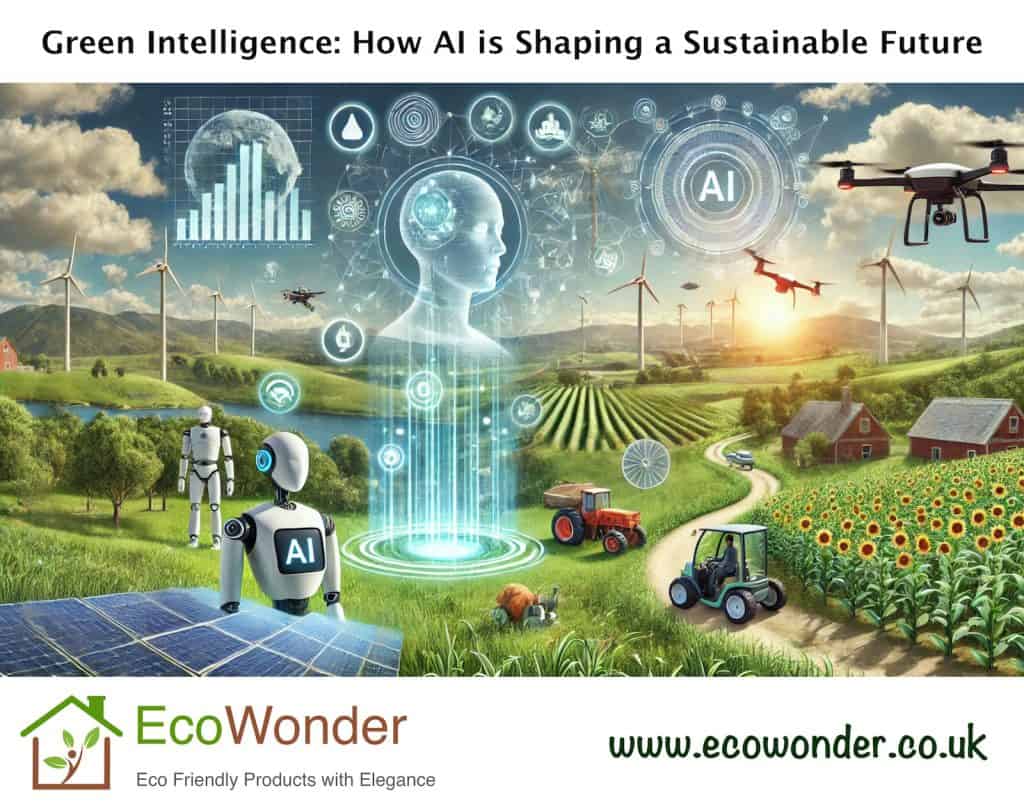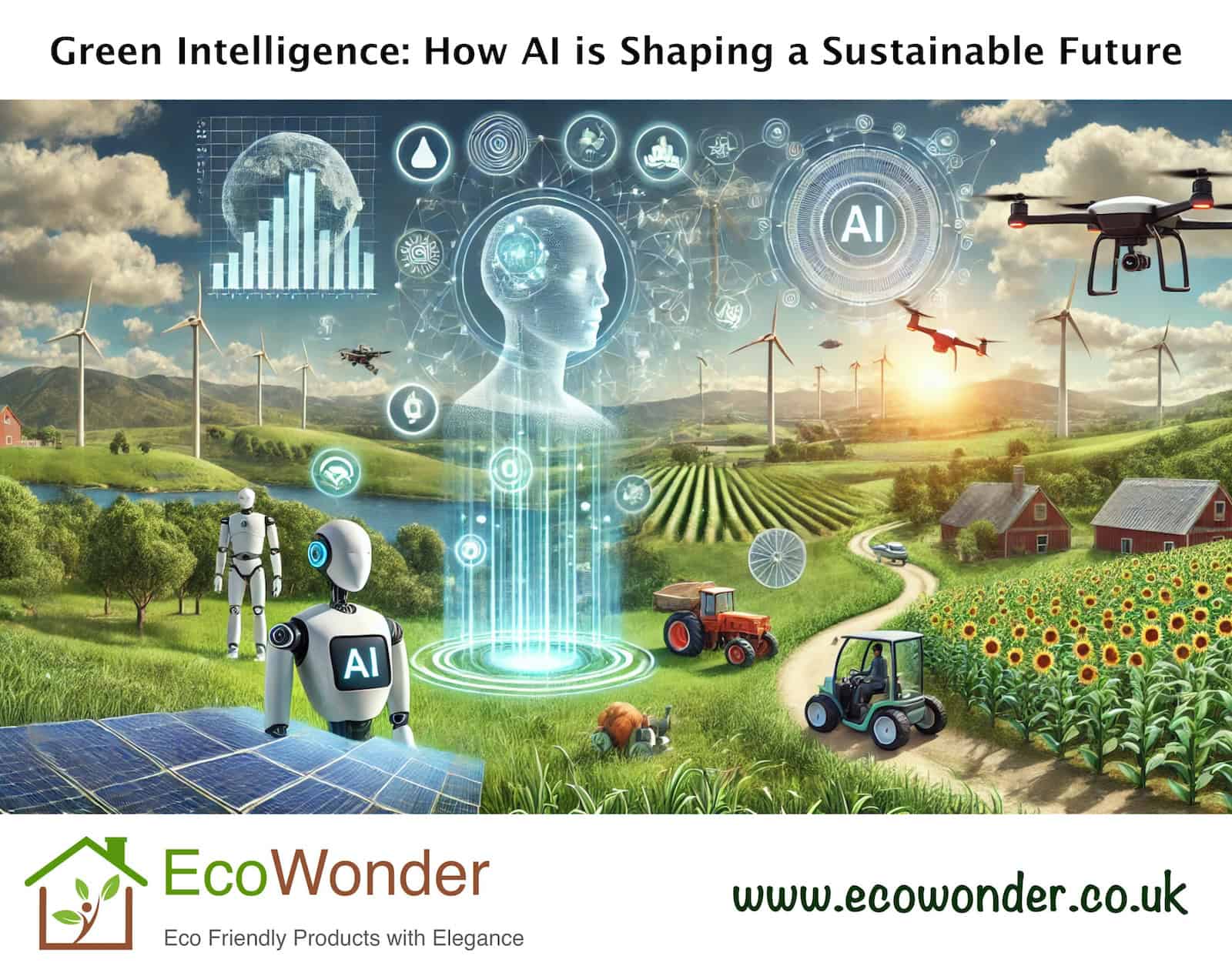Artificial Intelligence (AI) has become a transformative force in our world, affecting everything from healthcare to transportation, finance, and communication. While AI offers exciting possibilities for innovation and efficiency, it also presents environmental challenges. This article delves into AI’s environmental footprint, how AI can drive sustainability efforts, and the potential future of AI in building a greener world.

Meet Your New Smart Friend: What AI is and How It Works
Imagine you had a friend who could help you with almost anything, from finding the fastest route to work to recommending a new book based on your taste, or even predicting the weather tomorrow. That’s kind of what AI, or Artificial Intelligence, is like. But instead of a person, it’s a technology that can “learn” from data to make smart decisions, predict outcomes, or perform tasks that typically need human intelligence.
AI can look like many things: a virtual assistant such as the famous ChatGPT, a recommendation system on your favourite streaming platform, or even a self-driving car. At its core, AI learns patterns from vast amounts of information (often called data) and uses that knowledge to make sense of new information or to solve new problems.
AI can get incredibly powerful, especially with advances in areas like machine learning and deep learning. These are techniques that allow AI to improve over time, almost like how people learn from experience. AI has made amazing progress in just the past few years, and it’s now impacting nearly every industry in ways that are both exciting and, as we’ll discuss, sometimes challenging for the environment.
AI’s Current Environmental Footprint
Despite its revolutionary potential, AI has a significant environmental footprint. Training large-scale AI models, especially those based on deep learning, requires massive computational power. This demand for energy translates to a substantial carbon footprint. For instance, training a single large AI model can emit as much carbon dioxide as five cars would over their lifetime. This is largely because the hardware used to train AI models — powerful data centres filled with servers and GPUs — requires extensive energy for both processing and cooling.
Data centres are another contributor to AI’s carbon emissions. These centres host the servers that run AI applications and consume vast amounts of electricity. According to some estimates, data centres account for around 1% of global electricity demand, and this figure could rise as AI continues to grow. Although tech giants like Google, Amazon, and Microsoft have committed to using renewable energy to power their data centres, the industry as a whole faces a long road to achieving carbon neutrality.
How AI Can Improve Sustainability
While AI contributes to environmental impact, it also holds significant promise for reducing carbon emissions and promoting sustainability across industries. Here are some examples of how AI can drive sustainability efforts:
a. Energy Optimization
AI can help optimize energy use, reducing waste and lowering costs. For instance, machine learning algorithms can analyse data from smart grids to predict energy demand, allowing power companies to balance supply and demand more effectively. Google’s DeepMind AI has already been used to reduce energy usage in Google’s data centres by up to 40%, showcasing AI’s potential to make industrial operations more energy efficient.
b. Climate Modelling and Prediction
One of the most promising applications of AI is in climate science. AI models can analyse vast datasets, including temperature readings, satellite imagery, and historical weather patterns, to make predictions about climate change. These models help scientists understand how climate change will affect different regions, enabling policymakers to make informed decisions. Microsoft’s “AI for Earth” initiative, for example, supports projects that use AI to monitor ecosystems, manage water resources, and track biodiversity, helping to combat environmental degradation.
c. Sustainable Agriculture
AI has transformative potential in agriculture, helping farmers produce more food with fewer resources. AI-driven tools like precision agriculture use data from soil sensors, weather forecasts, and satellite imagery to optimize crop growth. This reduces water use, minimizes the need for fertilizers, and limits pesticide application, resulting in more sustainable farming practices. Drones powered by AI are also being used to monitor crops, detect diseases early, and even plant trees in reforestation projects.
d. Waste Management and Recycling
AI can play a significant role in improving waste management systems. Machine learning algorithms can sort recyclable materials more accurately and efficiently, reducing contamination and improving recycling rates. In some cities, AI is already being used to track waste collection routes and predict when trash bins are full, optimizing waste collection schedules and reducing unnecessary fuel consumption.
e. Sustainable Supply Chains
AI can help create more sustainable supply chains by providing insights into resource management and optimizing logistics. AI algorithms can track products from production to consumption, enabling companies to reduce waste, avoid overproduction, and minimize transportation emissions. For example, IBM’s Watson AI is being used to optimize supply chains in the food industry, helping to reduce food waste and lower carbon emissions.
The Future of AI and Sustainability
The future of AI and sustainability is both promising and challenging. As AI continues to evolve, its applications in environmental science, energy management, and sustainable development are likely to expand. The key to AI’s sustainable future, however, will lie in addressing its current environmental footprint and finding ways to make AI itself more sustainable.
Tech companies are increasingly aware of AI’s carbon footprint, and efforts are being made to develop more energy-efficient AI models. Some researchers are working on “green AI,” a concept that emphasizes efficiency and transparency in the computational costs of AI models. Additionally, hardware improvements, such as the development of more energy-efficient processors and cooling systems, will play a critical role in reducing AI’s energy consumption.
AI can also contribute to the development of renewable energy technologies. For example, machine learning models are being used to improve the efficiency of solar panels, forecast wind energy production, and optimize the operation of hydropower plants. By improving the performance of renewable energy sources, AI can help reduce reliance on fossil fuels and accelerate the transition to a low-carbon economy.
In conclusion, while AI has an environmental impact, it also offers unprecedented opportunities for promoting sustainability. By optimizing resource use, improving waste management, supporting climate science, and transforming industries like agriculture and energy, AI has the potential to power a greener, more sustainable future. The challenge moving forward will be to balance the benefits of AI with its environmental costs, ensuring that the technology itself is developed and used responsibly. With ongoing innovation and commitment to sustainability, AI can become a powerful ally in the global fight against climate change.






